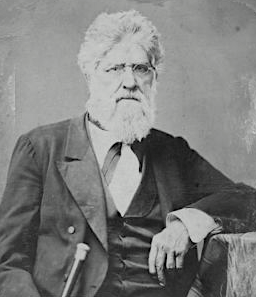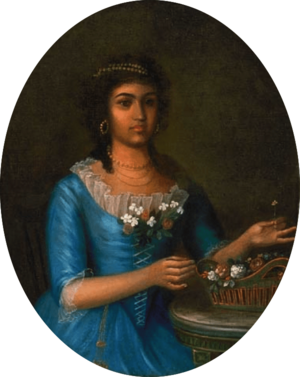Alexander Dimitry facts for kids
Quick facts for kids
Alexander Dimitry
|
|
|---|---|
 |
|
| U.S. Ambassador of Costa Rica & Nicaragua | |
| In office September 29, 1859 – April 27, 1861 |
|
| Preceded by | Mirabeau B. Lamar |
| Succeeded by | Charles N. Riotte |
| Personal details | |
| Born | February 7, 1805 New Orleans, Louisiana, USA |
| Died | January 30, 1883 (aged 77) New Orleans |
| Resting place | Saint Louis Cemetery No. 1 |
| Spouse |
Mary Powell Mills
(m. 1835–1883) |
| Children | John Smith Dimitry |
| Alma mater | Georgetown University |
| Profession | Lawyer, Statesman, Educator |
| Known for | Education, Diplomacy |
Alexander Dimitry (born February 7, 1805 – died January 30, 1883) was a smart and important person from Louisiana. He was known as a Louisiana Creole.
He was the first person to lead public education in Louisiana. He was also a writer, a diplomat (someone who represents their country), a teacher, a journalist, and a lawyer. Alexander Dimitry could speak eleven different languages! He was the first person of color to be an Ambassador for the United States. He served in Costa Rica and Nicaragua. He was also one of the few people of color to work for the Confederate Government during the American Civil War. He was also the first person of color to attend Georgetown University.
Contents
Family Life
Alexander Dimitry was born in New Orleans on February 7, 1805. His parents were Andrea Dimitry and Marianne Céleste Dragon. His father, Andrea, was from Greece. He moved to New Orleans in 1799. Andrea fought in the War of 1812 alongside Major General Andrew Jackson.
Alexander's mother, Marianne, also had Greek family roots. Her father, Michel Dragon, was a Greek immigrant and fought in the American Revolution. Alexander's maternal grandmother, Françoise Monplaisir, was born free in New Orleans. Marianne Céleste Dragon was also born free.
Alexander was one of ten children in his family. His brothers and sisters included Euphrosine, Mannella Airnée, Constantine Andrea, and John Baptiste Miguel Dracos. His other siblings were Clino Angelica, Marie Francesca Athenais, Nicholas Dimitry, Mathilde Elizabeth Theophainie, and Antonie Marie.
His Education
Alexander Dimitry was very smart from a young age. By the time he was ten, he was learning from private teachers. He could speak ancient Greek and Latin very well. He also spoke English, French, Greek, Italian, and Spanish.
When he was fifteen, Alexander went to Georgetown University in Washington, D.C. He finished his studies there in 1826. After college, he returned to New Orleans. He then studied law to become a lawyer.
Alexander passed his law exams and started working as a lawyer. He knew a lot about different types of law. But he was more interested in teaching, writing, and languages. He became a professor at the College of Baton Rouge. After two years, he moved back to New Orleans. There, he helped run a French newspaper called L'Abeille. He was the first editor for the English parts of the paper.
His Career
Alexander often traveled to Washington D.C. There, he met Mary Powell Mills. Mary was the daughter of Robert Mills, a famous architect. Robert Mills designed the Washington Monument. Alexander and Mary got married in Washington D.C. on April 5, 1835. In the same year, Alexander became a main clerk for the postal department in the Southwest. He worked in this job for four years.
The U.S. Congress chose Dimitry to be a secretary for a group sent to Mexico. This group was trying to solve problems between the two countries. Alexander's knowledge of Spanish and international law made him very helpful. When he came back to Louisiana, he started a college in Saint Charles Parish. He was the head of this college. Later, Dimitry became the superintendent of schools in New Orleans. Around this time, he also taught a well-known writer named Mary Bushnell Williams.
The Governor of Louisiana, Isaac Johnson, chose Alexander Dimitry to be the state superintendent of public education. This was a very important job. Alexander was the first person of color to hold this position in Louisiana. His job was to organize the public school system across the entire state. He held this important role from 1847 to 1854.
In 1853, Alexander's nephew, George Pandelly, ran for a local government position in New Orleans. His opponent tried to spread rumors about George's family background. This led to a court case. The case was dismissed, but it caused some family members to create a new story about their family history.
After being superintendent, Alexander went to Washington D.C. He was called there by William L. Marcy, who was the Secretary of State. Alexander was asked to help change some agreements with Native American tribes. In 1855, the U.S. Department of State hired him to translate important letters from other countries. He was very good at this because he spoke eleven languages. While working at the State Department, he also gave talks at Georgetown University.
In 1859, President Buchanan appointed him as the United States minister (ambassador) to Costa Rica and Nicaragua. His job was to help solve problems between countries. Alexander was very important because he could speak the local languages. He gave important speeches in Spanish at official events. He knew a lot about Central America. Alexander was close to making a new agreement with Nicaragua. But the negotiation ended when South Carolina decided to leave the United States. Louisiana also decided to leave.
Alexander was worried about his large family in New Orleans and his home state. So, he resigned from his job as Ambassador. The Secretary of State, William H. Seward, told Alexander that President Abraham Lincoln was not happy with his decision. Alexander gave up a very high salary to return home. Alexander's son, John Dimitry, was also very educated. He worked with his father as a secretary for the ambassador's office in Costa Rica and Nicaragua.
During the Civil War
Alexander Dimitry's son, John, fought as a soldier in the American Civil War. He was part of the Crescent City Native Guards. During the war, Alexander traveled to Richmond, Virginia. There, he worked as the chief clerk for the Postmaster General. He later became the Assistant Postmaster General for the Confederacy. The Postmaster was John Henninger Reagan. His son John was hurt in the war but later joined his father at the Postmaster's office. Alexander's other son, Alexander Godgrand Dimitry, died in the Civil War. He was killed in battle near Germantown, Maryland.
Even though Dimitry worked for the Confederate government, not everyone respected him. In 1861, Dimitry asked General P. G. T. Beauregard for the body of a Union soldier, James Cameron, who died in battle. Dimitry signed his letter as "Old Friend + Fellow Louisianan." But Beauregard replied that he would not listen to someone who had left the Confederate cause.
On September 4, 1865, President Andrew Johnson gave Alexander a special pardon. This pardon forgave him for his part in the American Civil War. After the war ended, Alexander's family moved to Brooklyn, New York.
Later Life and Death
In 1868, the family moved back to New Orleans. One year later, Alexander became a Latin professor at Christian Brothers College in Mississippi. By the 1870s, Alexander Dimitry's family was very large, with over 100 relatives in New Orleans. They were a powerful and connected Greek-American Creole family. His son John helped write a book about Jefferson Davis, a leader of the Confederacy. In 1875, Alexander wrote an article for a Louisiana newspaper called The Creole Defined. In it, he explained the meaning of the word "creole."
Alexander spent the rest of his life at Christian Brothers College. He kept writing articles for newspapers and gave talks all over the South. He often spoke at building dedication ceremonies and was a well-known scholar. His talks included his ideas on Earth's Fitness for Man. This lecture discussed how the Earth, light, and animals were formed, and how humans relate to the universe. He also spoke at graduation ceremonies at the Peabody Normal Seminary many times. He was a member of a group called the Order of Heptasophs. Alexander Dimitry died at his home in New Orleans in 1883. Many of his writings were never published.
Alexander Dimitry and Mary Powell Mills had ten children. Their names were John Bull Smith Dimitry, Charles Patton Dimitry, Eliza Virginia Mills Dimitry, Mary Elizabeth Lynn Dimitry, Alexander Godgrand Dimitry, Mathilde Fortier Dimitry, Mills Miller, Robert Mills Dimitry, Robert Andrea Dimitry, Thomas Daney Dimitry, and Ernest Alexander Lagarde Dimitry.
Literary Works
- Address by Mr. Alexander Dimitry 1839
- Lecture on the Study of History, Applied to the Progress of Civilization 1839
Popular Media
The Dimitry family has been featured in many articles, books, and films.
- His mother Marianne Celeste Dragon's portrait was on the cover of the 2009 book Exiles at Home by Shirley Elizabeth Thompson.
- Marianne Celeste Dragon was also featured in the 2013 book Behind Closed Doors Art in the Spanish American Home, 1492-1898 by Mia L. Bagneris, Michael A. Brown, and Suzanne L. Stratton-Pruitt.


